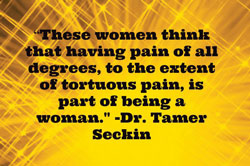March is Endometriosis Awareness Month and organizations such as the Endometriosis Foundation of America have been working hard to bring awareness to this medical condition.
According to the Endometriosis Foundation of America, endometriosis can be defined as, “when tissue similar to the endometrium (the lining of the uterus) is found outside the uterus on other parts of the body.”
It affects an estimated 6.3 million women and girls in the U.S., about 176 million women worldwide, and is found in one in 10 women on average. Due to lack of knowledge about the disease by both doctors and patients, the average diagnosis period for women with endometriosis is 10 years in the U.S.
Often, women are not taken seriously or are misdiagnosed, leading to a delay in the proper diagnosis. There is little known about the disease and there is no cure; even a hysterectomy will not relieve a patient of their symptoms.
One of the key elements in achieving awareness to this disease is eliminating the stigma that is associated with talking about a woman’s period. Women are expected to keep quiet about their periods and to suffer through their monthly pain quietly. They are expected to continue to go to work, school, and social events and act as if nothing is troubling them.
If a woman does speak up about her pain, she is often viewed as being dramatic and her comments are overlooked. However, it is this behavior that leads to delays in diagnosis, and even misdiagnosis, of endometriosis and other gynecological conditions.
“It’s a disease of periods, really, and in general there is a lot of societal misconception about periods and menstruation. People still don’t talk about their periods openly,” said Dr. Tamer Seckin, an endometriosis expert, in an interview with actress and director Lena Dunham. “These women think that having pain of all degrees — to the extent of tortuous pain — is part of being a woman. That suffering and pain is part of their sexuality. But this pain is not normal, and the taboo that surrounds it must not be either,” he continued.
After I was diagnosed in October of 2014, I started to conduct my own research on the topic. I found that there is an entire community of women who are affected by the disease and who speak out about the issue, even though at times it may feel like no one is listening.
One of these women is 31-year-old Maria Gonzalez, who biked about 3,000 miles from Toronto, Canada to Tijuana, Mexico with the goal of raising awareness on the issue.
Unfortunately, her story received little attention and was only featured as a short write up in Cosmopolitan. She has had the disease for 13 years and is quoted as saying, “Living with endometriosis for so many years makes you very uncertain and limits you a lot because you never know when the pain will strike.”
Another woman, Lizzie O’Leary, a journalist, also decided to speak out about her struggles with the disease. Her story, which is featured in Cosmopolitan as well, described how it took her doctors 21 years to properly diagnose her. Part of her intestines and her appendix needed to be removed because they had been permanently damaged by endometriosis.
Dunham is one of the few celebrities to openly discuss her issue with the disease. She has unveiled her struggles in her book Not that Kind of Girl and has recently written an essay for Lenny Letters about the topic. In the essay, she described her experience and how it has affected her work, social, and romantic life.
“I know I’m lucky in the grand health scheme, but I also know that I am one of many women who grasp for a sense of consistent well-being, fight against the betrayals of their bodies, and who are often met with skepticism by doctors trained to view painful periods as the lot of women who should learn to grin and bear it,” said Dunham.
It is comforting that there are women trying to bring attention to this issue, many even going to extreme lengths to do so. However, major news outlets do not cover the topic, which makes their efforts less effective.
If people were more open to talking about a woman’s period, then more awareness could be brought to endometriosis. Women need to talk to each other about their menstrual cycles, that way women can know when what they are experiencing is not normal.
Men also need to talk to women about the issue, so they can be more aware, mindful, and educated about women’s bodies, nd doctors need to be more open with one another as well as with their patients. They need to discuss these topics more often with their patients so that they can be properly diagnosed with endometriosis as soon as possible.
It really doesn’t take much to bring awareness to endometriosis when you think about it. All people need to do is talk more about women’s periods. The hard part is getting people to initiate these conversations.
IMAGE COURTESY of Danielle Schipani


